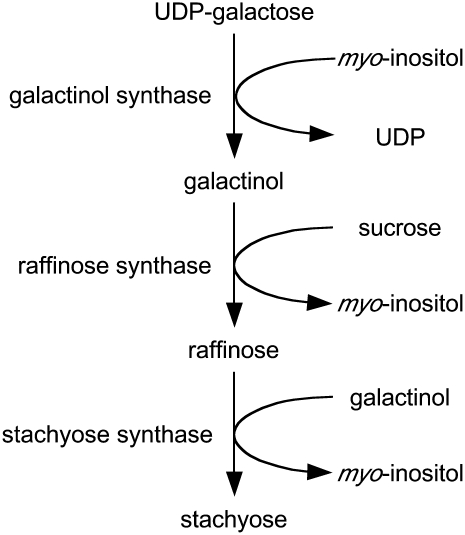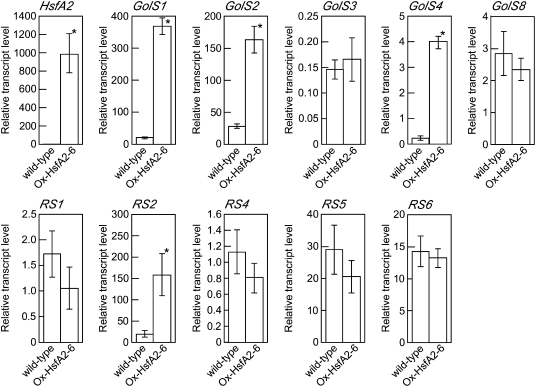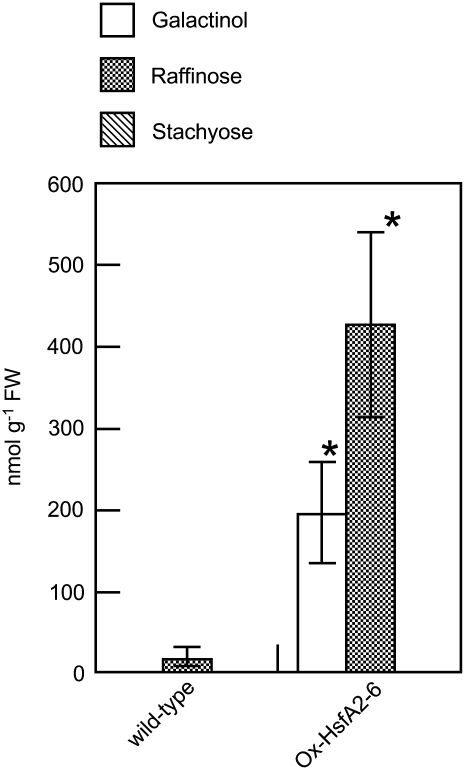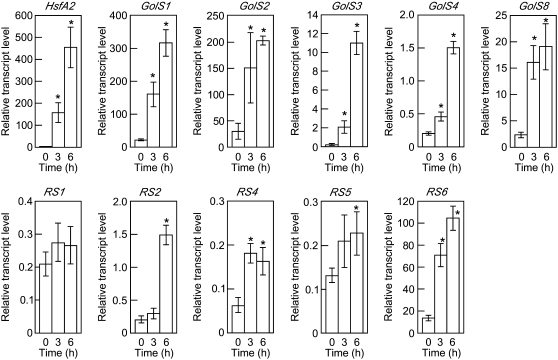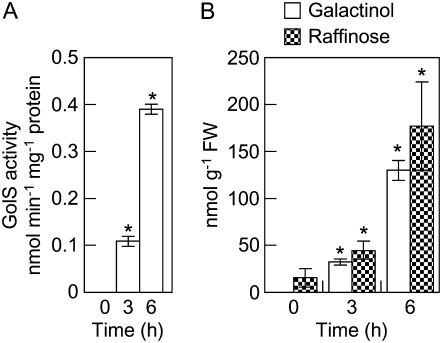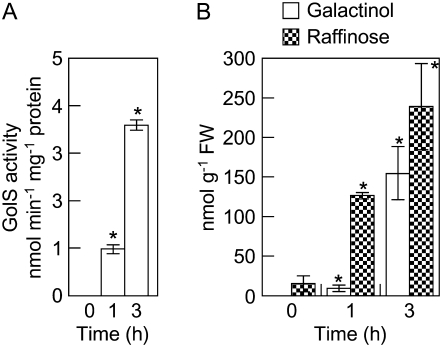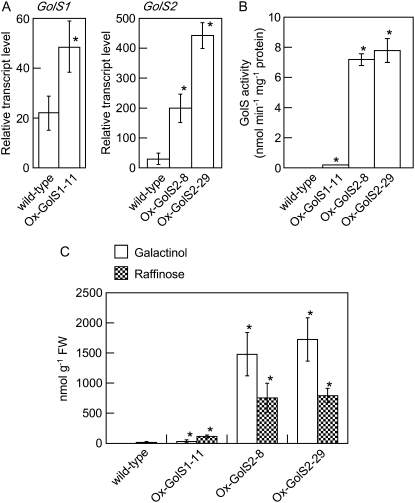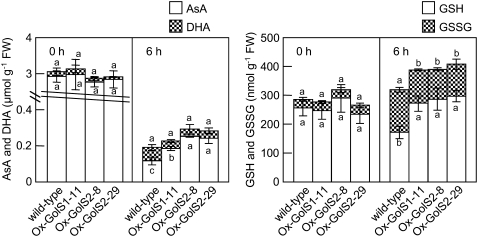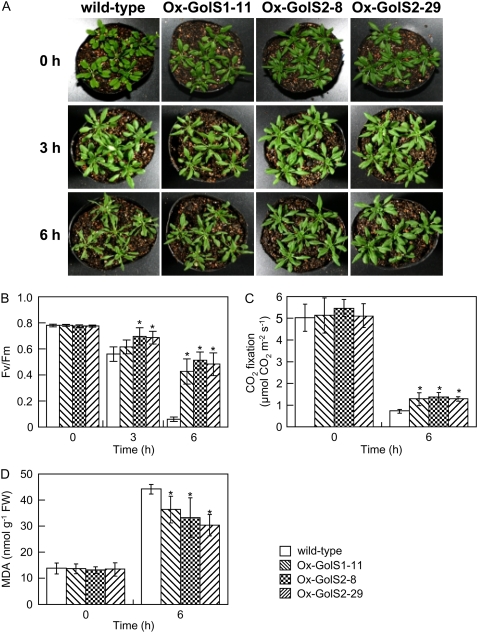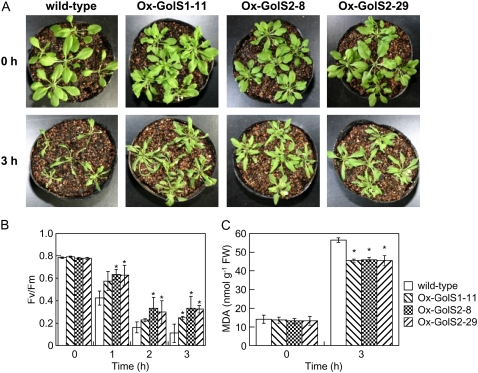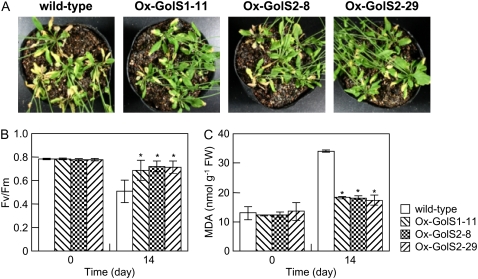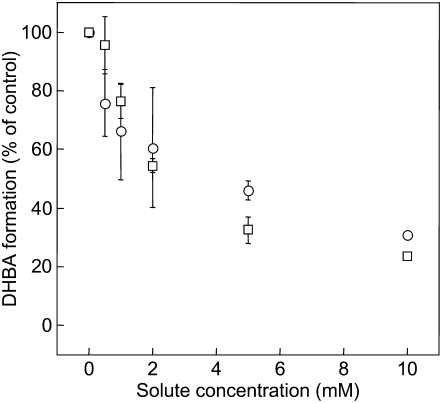Abstract
Galactinol synthase (GolS) is a key enzyme in the synthesis of raffinose family oligosaccharides that function as osmoprotectants in plant cells. In leaves of Arabidopsis (Arabidopsis thaliana) plants overexpressing heat shock transcription factor A2 (HsfA2), the transcription of GolS1, -2, and -4 and raffinose synthase 2 (RS2) was highly induced; thus, levels of galactinol and raffinose increased compared with those in wild-type plants under control growth conditions. In leaves of the wild-type plants, treatment with 50 μm methylviologen (MV) increased the transcript levels of not only HsfA2, but also GolS1, -2, -3, -4, and -8 and RS2, -4, -5, and -6, the total activities of GolS isoenzymes, and the levels of galactinol and raffinose. GolS1- or GolS2-overexpressing Arabidopsis plants (Ox-GolS1-11, Ox-GolS2-8, and Ox-GolS2-29) had increased levels of galactinol and raffinose in the leaves compared with wild-type plants under control growth conditions. High intracellular levels of galactinol and raffinose in the transgenic plants were correlated with increased tolerance to MV treatment and salinity or chilling stress. Galactinol and raffinose effectively protected salicylate from attack by hydroxyl radicals in vitro. These findings suggest the possibility that galactinol and raffinose scavenge hydroxyl radicals as a novel function to protect plant cells from oxidative damage caused by MV treatment, salinity, or chilling.
The raffinose family oligosaccharides (RFOs), such as raffinose, stachyose, and verbascose, are soluble galactosyl-Suc carbohydrates. As shown in Figure 1, RFOs are synthesized from Suc by the subsequent addition of activated Gal moieties donated by galactinol (Peterbauer and Richter, 2001). Galactinol synthase (GolS; EC 2.4.1.123) catalyzes the first committed step in the biosynthesis of RFOs and plays a key regulatory role in the carbon partitioning between Suc and RFOs (Saravitz et al., 1987). In fact, overexpression of Arabidopsis (Arabidopsis thaliana) GolS2 in transgenic Arabidopsis plants caused an increase in the levels of endogenous galactinol and raffinose under normal conditions (Taji et al., 2002). Raffinose synthase (RS; EC 2.4.1.82) catalyzes the synthesis of raffinose from Suc and galactinol (Lehle and Tanner, 1973).
Figure 1.
Biosynthetic pathway of galactinol, raffinose, and stachyose in plants.
RFOs accumulate in the late stages of soybean (Glycine max) seed maturation and desiccation, indicating that they play a role in the desiccation tolerance of seeds as osmoprotectants (Saravitz et al., 1987; Castillo et al., 1990). Furthermore, RFOs protect unilamellar liposomes from dehydration by direct sugar-membrane interactions in vitro (Hincha et al., 2003). In thylakoid membrane of chloroplasts isolated from spinach (Spinacia oleracea) leaves under freezing, drought, or heat stress conditions, raffinose has been found to reduce the inactivation of the electron (2,6-dichlorophenolindophenol reduction) and cyclic photophosphorylation in photosynthesis (Santarius, 1973).
Recently, it was reported that the expression of enzymes related to the biosynthesis of galactinol and RFOs and their intracellular accumulation in plant cells are closely associated with the responses to environmental stresses (Taji et al., 2002; Kaplan et al., 2004, 2007; Panikulangara et al., 2004; Peters et al., 2007). The GolS activity in kidney bean (Phaseolus vulgaris) seeds increased upon exposure of plants to cold conditions (Liu et al., 1998). The expression of GolS genes in Arabidopsis and Ajuga reptans plants was induced by cold stress (Sprenger and Keller, 2000; Taji et al., 2002). The insertion of T-DNA into the GolS1 gene in Arabidopsis plants impaired the increase in galactinol and raffinose contents at 2 h after heat stress treatment (Panikulangara et al., 2004). In knockout RS5 Arabidopsis mutants, the accumulation of raffinose was not observed during chilling stress (Zuther et al., 2004). In leaves of tomato (Solanum lycopersicum) and Arabidopsis seedlings, the transcript levels of GolS and RS increased under environmental stress, such as cold and desiccation (Downie et al., 2003; Zuther et al., 2004). Arabidopsis contains seven genes that belong to the GolS family. Among them, GolS1 and GolS2 mRNAs were detected in mature seeds and also induced by drought, salt, or heat stress in leaf tissue, while GolS3 mRNA was induced by cold stress (Taji et al., 2002; Panikulangara et al., 2004).
It is generally accepted that the imposition of environmental stress, such as drought, chilling, heat, and high-light irradiation, gives rise to excess concentrations of reactive oxygen species (ROS) and that much of the injury to plants caused by exposure to stress is associated with oxidative damage at the cellular level (Bowler et al., 1992; Foyer et al., 1994; Alscher et al., 1997; Shigeoka et al., 2002).
It has been reported that the expression of Arabidopsis GolS1 and GolS2 is regulated by a heat shock transcription factor (HSF), such as HsfA1a, HsfA1b, and/or HsfA2 (Panikulangara et al., 2004; Busch et al., 2005; Schramm et al., 2006). Recently, we reported that the transcription of GolS1 and GolS2 is induced by a combination of high-light and heat stress or treatment with hydrogen peroxide, as is the transcription of HsfA2 (Nishizawa et al., 2006). Based on the data reported so far, it seems likely that galactinol and RFOs protect plant cells from the oxidative damage caused by various types of stress condition.
To explore the relationship between the roles of galactinol and/or raffinose and oxidative stress conditions, we studied the expression of GolS and RS isoenzymes and the levels of galactinol and raffinose in HsfA2-overexpressing plants and in wild-type plants under control growth conditions. Next, we evaluated the tolerance of oxidative stress in GolS1- and GolS2-overexpressing transgenic plants under several types of environmental stress. Furthermore, we determined the abilities of galactinol and raffinose as scavengers of the hydroxyl radical in vitro. Finally, we discuss the potential of galactinol and raffinose as novel intracellular antioxidants in plants under several types of stress.
RESULTS
Expression of GolS and RS Genes and Accumulation of Galactinol and Raffinose in the HsfA2-Overexpressing Plants
Seven GolS genes (GolS1 to GolS7) and three putative GolS genes (designated GolS8 to GolS10; At3g28340, At3g06260, and At5g30500, respectively) as well as six putative raffinose synthase genes (designated RS1 to RS6; At1g55740, At3g57520, At4g01265, At4g01970, At5g40390, and At5g20250, respectively) were identified from the Arabidopsis genome databases (National Center for Biotechnology Information, Arabidopsis Genome View [http://www.ncbi.nlm.nih.gov/mapview/map_search.cgi?taxid=3702] and The Arabidopsis Information Resource [http://www.arabidopsis.org/index.jsp]). Recently, we reported that expression of GolS1 and GolS2 is under the control of HsfA2 in Arabidopsis plants (Nishizawa et al., 2006). Then, the expression of all GolS genes (GolS1 to GolS10) and RS genes (RS1 to RS6) in the HsfA2-overexpressing transgenic Arabidopsis plants (Ox-HsfA2-6) was examined using quantitative PCR analysis. In leaves of the Ox-HsfA2-6 plants, the level of the HsfA2 transcript was approximately 330-fold higher than that in wild-type plants (Fig. 2). The transcription of GolS1, -2, and -4 and RS2 was highly induced in leaves of the Ox-HsfA2-6 plants compared with those of the wild-type plants under control growth conditions (25°C, 100 μE m−2 s−1; Fig. 2). GolS5, -6, -7, -9, and -10 and RS3 were hardly expressed in leaves of wild-type and Ox-HsfA2-6 plants under control growth conditions (data not shown).
Figure 2.
Expression of the HsfA2, GolS, and RS genes in the leaves of wild-type and Ox-HsfA2 plants. Four-week-old wild-type and Ox-HsfA2-6 plants grown under control growth conditions were used for the analysis. The procedures are described in the “Materials and Methods.” Relative amounts were normalized to Actin2 mRNA (=100%). Mean ± sd values from three experiments are shown. Asterisks indicate that the values are significantly different from those in the wild-type plants (P < 0.05).
We determined the levels of galactinol and RFOs in the leaves of wild-type and Ox-HsfA2-6 plants under control growth conditions (Fig. 3). In the wild-type plants, galactinol was undetected and the level of raffinose was 16.2 ± 10.2 nmol g−1 fresh weight. Galactinol and raffinose markedly accumulated in the Ox-HsfA2-6 plants (194 ± 60.4 and 425 ± 112 nmol g−1 fresh weight).
Figure 3.
Galactinol, raffinose, and stachyose contents in the leaves of wild-type and Ox-HsfA2 plants. Four-week-old wild-type and Ox-HsfA2-6 plants grown under control growth conditions were used for the analysis. The procedures are described in “Materials and Methods.” Mean ± sd values from three experiments are shown. Asterisks indicate that the values are significantly different from those in the wild-type plants (P < 0.05). FW, Fresh weight.
Expression of GolS and RS Genes and Accumulation of Galactinol and Raffinose in Wild-Type Plants under Oxidative Stress
We analyzed the expression of the GolS and RS genes following oxidative damage caused by treatment with 50 μm methylviologen (MV), an enhancer of the production of O2−, under control growth conditions (25°C, 100 μE m−2 s−1). The transcription of GolS1, -2, -3, -4, and -8 and RS2, -4, -5, and -6 in the wild-type plants was induced at 3 and 6 h after treatment with MV (Fig. 4). The transcript level of RS1 was not changed by the MV treatments. GolS5, -6, -7, -9, and -10 and RS3 were expressed in neither MV-treated nor untreated plants (data not shown). The total activity of GolS isoenzymes in the leaves of Arabidopsis plants was not detected under control growth conditions; however, at 3 and 6 h after treatment with MV under control growth conditions, the activities were 0.11 ± 0.01 and 0.39 ± 0.01 nmol min−1 mg−1 protein, respectively (Fig. 5A). In the untreated plants, galactinol and raffinose were hardly detectable. At 3 h after treatment with MV under control growth conditions (100 μE m−2 s−1), the levels of galactinol and raffinose were 32.2 ± 3.6 and 44.5 ± 9.8 nmol g−1 fresh weight, respectively, and at 6 h, their levels were 130.7 ± 10.5 and 177.2 ± 46.5 nmol g−1 fresh weight, respectively (Fig. 5B). At 1 and 3 h after treatment with MV under high light (1,600 μE m−2 s−1), the activities were 1.0 ± 0.1 and 3.6 ± 0.1 nmol min−1 mg−1 protein, respectively (Fig. 6A). The levels of galactinol and raffinose were 154.4 ± 34.0 and 239.2 ± 55.0 nmol g−1 fresh weight at 3 h after treatment with MV under high-light conditions (Fig. 6B).
Figure 4.
Effects of treatment with MV under control growth conditions on the transcript levels of HsfA2, GolS, and RS genes in the leaves of wild-type plants. Four-week-old wild-type plants grown in soil under control growth conditions were sprayed with MV (50 μm) in 0.1% Tween 20 (5 mL) and then transferred to control growth conditions (100 μE m−2 s−1) for 6 h. The procedures are described in “Materials and Methods.” Relative amounts were normalized to Actin2 mRNA (100%). Mean ± sd values from three experiments are shown. Asterisks indicate that the values are significantly different from those in the wild-type plants (P < 0.05).
Figure 5.
Effects of treatment with MV under control growth conditions on total GolS activity and galactinol and raffinose contents in the leaves of wild-type plants. Four-week-old wild-type plants grown in soil under control growth conditions were sprayed with MV (50 μm) in 0.1% Tween 20 (5 mL) and then transferred to control growth conditions (100 μE m−2 s−1) for 6 h. A, Total GolS activities. B, Galactinol and raffinose contents. Mean ± sd values from three experiments are shown. Asterisks indicate that the values are significantly different from those in the wild-type plants (P < 0.05).
Figure 6.
Effects of treatment with MV under high-light conditions on total GolS activity and galactinol and raffinose contents in the leaves of wild-type plants. Four-week-old wild-type plants grown in soil under control growth conditions were sprayed with MV (50 μm) in 0.1% Tween 20 (5 mL) and then transferred to high-light conditions (1,600 μE m−2 s−1) for 1 and 3 h. A, Total GolS activities. B, Galactinol and raffinose contents. Mean ± sd values from three experiments are shown. Asterisks indicate that the values are significantly different from those in the wild-type plants (P < 0.05).
Isolation and Characterization of Knockout GolS1 and Knockdown GolS2 and GolS3 Mutants
To explore the roles of galactinol and/or raffinose under oxidative stress conditions, we isolated and characterized the GolS1, GolS2, or GolS3 mutants containing a T-DNA insert in each gene (SALK_121059, SALK_101144, or SAIL_558_G10) from the SIGnAL project (signal.salk.edu/tabout.html), because among seven GolS genes, the transcript levels of GolS1, -2, or -3 have been found to be relatively higher than those of other GolS genes under stressful conditions (Taji et al., 2002; Busch et al., 2005). The T-DNA insert sites are shown in Supplemental Figure S1A. The growth and appearance of these mutants were similar to those of wild-type plants under control growth conditions (Supplemental Fig. S1B).
Four-week-old wild-type and mutant plants were treated with 50 μm MV under control growth conditions (25°C, 100 μE m−2 s−1). Quantitative PCR analysis revealed that the T-DNA insertion in the GolS1 gene resulted in the complete loss of GolS1 expression at the transcript level under control growth or stressful conditions (Supplemental Fig. S2). The T-DNA insertion in the GolS2 or the GolS3 gene caused the significant reduction of GolS2 or GolS3 expression at the transcript level under control growth or stressful conditions (Supplemental Fig. S2). Therefore, these mutants were designated as knockout GolS1 (KO-GolS1) or knockdown GolS2 or GolS3 (KD-GolS2 or KD-GolS3) mutants.
Total activities of GolS isoenzymes were not detected in the wild type or in KO-GolS1, KD-GolS2, and KD-GolS3 mutants under control growth conditions (Supplemental Fig. S3A). No significant differences were observed in total GolS activities and levels of galactinol and raffinose between the wild type and KO-GolS1, KD-GolS2, and KD-GolS3 mutants under stressful conditions (Supplemental Fig. S3, A and B). In addition, no significant differences were observed in the transcript levels of other GolS genes between wild-type, KO-GolS1, KD-GolS2, and KD-GolS3 plants under stressful conditions (Supplemental Fig. S2).
Evaluation of Oxidative Stress Tolerance in GolS1- and GolS2-Overexpressing Transgenic Plants
Next, we generated transgenic Arabidopsis plants overexpressing GolS1 (Ox-GolS1) and obtained GolS2-overexpressing transgenic Arabidopsis plants (Ox-GolS2) from Taji et al. (2002). In the Ox-GolS1-11 plants, the transcript levels of GolS1 were approximately 2-fold higher than those in the wild-type plants under control growth conditions (Fig. 7A). In the Ox-GolS2-8 and Ox-GolS2-29 plants, the transcript levels of GolS2 were approximately 7- and 15-fold higher, respectively, than those in the wild-type plants (Fig. 7A). No difference was observed in transcript levels of RS1, -2, -4, -5, and -6 between the wild-type, Ox-GolS1-11, Ox-GolS2-8, and Ox-GolS2-29 plants under control growth conditions (data not shown). The total activities of GolS isoenzymes in the leaves of the Ox-GolS1-11, Ox-GolS2-8, and Ox-GolS2-29 plants were 0.20 ± 0.01, 7.2 ± 0.4, and 7.8 ± 0.8 nmol min−1 mg−1 protein, respectively, under control growth conditions (Fig. 7B). Galactinol and raffinose were significantly accumulated in the Ox-GolS1-11, Ox-GolS2-8, and Ox-GolS2-29 plants under control growth conditions (Fig. 7C). The levels of galactinol in the Ox-GolS1-11, Ox-GolS2-8, and Ox-GolS2-29 plants were 40.4 ± 18.8, 1,479 ± 349, and 1,727 ± 366 nmol g−1 fresh weight, respectively, and the levels of raffinose in those transgenic plants were 121 ± 28.9, 754.3 ± 232, and 788.5 ± 100 nmol g−1 fresh weight, respectively, under control growth conditions. No significant differences in the levels of ascorbate (AsA) and reduced glutathione (GSH) were detected between the wild-type, Ox-GolS1-11, Ox-GolS2-8, and Ox-GolS2-29 plants (Fig. 8). In addition, PSII activities (variable fluorescence [Fv]/maximal fluorescence [Fm]) and the CO2 fixation in Ox-GolS1-11, Ox-GolS2-8, and Ox-GolS2-29 plants were the same as those in the wild type under control growth conditions (Fig. 9, B and C). No difference was observed in the growth or morphology between the wild-type, Ox-GolS1-11, Ox-GolS2-8, and Ox-GolS2-29 plants under control growth conditions (Fig. 9A).
Figure 7.
The expression levels of the transgene and galactinol and raffinose contents in the leaves of Ox-GolS1 and Ox-GolS2 plants. Four-week-old wild-type, Ox-GolS1-11, Ox-GolS2-8, and Ox-GolS2-29 plants grown under control growth conditions were used for the analysis. The procedures are described in “Materials and Methods.” A, The transcript level of GolS1 or GolS2. Relative amounts were normalized to Actin2 mRNA (100%). B, Total GolS activities. C, Galactinol and raffinose contents. Mean ± sd values from three experiments are shown. Asterisks indicate that the values are significantly different from those in the wild-type plants (P < 0.05).
Figure 8.
Effects of MV treatment under control growth conditions on AsA and GSH contents in the leaves of wild-type, Ox-GolS1, and Ox-GolS2 plants. Four-week-old wild-type, Ox-GolS1-11, Ox-GolS2-8, and Ox-GolS2-29 plants grown in soil under control growth conditions were sprayed with MV (50 μm) in 0.1% Tween 20 (5 mL) and then transferred to control growth conditions (100 μE m−2 s−1) for 6 h. The procedures are described in “Materials and Methods.” Mean ± sd values from three experiments are shown. Different letters indicate significant differences (P < 0.05).
Figure 9.
Effects of MV treatment under control growth conditions on phenotype, PSII activity, CO2 fixation, and lipid hydroperoxide levels in the leaves of wild-type, Ox-GolS1, and Ox-GolS2 plants. Four-week-old wild-type, Ox-GolS1-11, Ox-GolS2-8, and Ox-GolS2-29 plants grown in soil under control growth conditions were sprayed with MV (50 μm) in 0.1% Tween 20 (5 mL) and then transferred to control growth conditions (100 μE m−2 s−1) for 6 h. A, Phenotypes of plants exposed to oxidative stress. B, Effects of the stress on PSII activity in wild-type, Ox-GolS1-11, Ox-GolS2-8, and Ox-GolS2-29 plants. The PSII activity (Fv/Fm) in the rosette leaves of Arabidopsis plants was determined at 25°C after adaptation to the dark for 30 min. C, CO2 fixation in wild-type, Ox-GolS1-11, Ox-GolS2-8, and Ox-GolS2-29 plants. D, Lipid peroxidation expressed as MDA content in wild-type, Ox-GolS1-11, Ox-GolS2-8, and Ox-GolS2-29 plants. Mean ± sd values from three experiments are shown. Asterisks indicate that the values are significantly different from those in the wild-type plants (P < 0.05).
Four-week-old wild-type, Ox-GolS1-11, Ox-GolS2-8, and Ox-GolS2-29 plants were treated with 50 μm MV under control growth conditions (25°C, 100 μE m−2 s−1). Although the PSII activities and the CO2 fixation of the wild-type, Ox-GolS1-11, Ox-GolS2-8, and Ox-GolS2-29 plants decreased considerably, the PSII activities and the CO2 fixation of Ox-GolS1-11, Ox-GolS2-8, and Ox-GolS2-29 plants were significantly higher than those of wild-type plants under stressful conditions (Fig. 9, B and C). However, no differences were observed in the MV-tolerant phenotype, the PSII activity, and the CO2 fixation between the Ox-GolS1-11, Ox-GolS2-8, and Ox-GolS2-29 plants under stressful conditions (Fig. 9, A–C). The malondialdehyde (MDA) levels were elevated in both wild-type and transgenic plants, but the lipid peroxidation in the transgenic plants was significantly lower than that in the wild-type plants under stressful conditions (Fig. 9D). The levels of AsA at 6 h after MV treatment under control growth conditions were drastically decreased in the wild-type and Ox-GolS plants; however, they remained significantly high in the Ox-GolS1-11, Ox-GolS2-8, and Ox-GolS2-29 plants compared with those in the wild-type plants (Fig. 8). By contrast, the levels of dehydroascorbate in the wild-type, Ox-GolS1-11, Ox-GolS2-8, and Ox-GolS2-29 plants hardly changed. The levels of GSH in wild-type plants decreased to 66% after 6 h under stressful conditions, while those in the Ox-GolS1-11, Ox-GolS2-8, and Ox-GolS2-29 plants hardly changed. The levels of oxidized glutathione (GSSG) in wild-type, Ox-GolS1-11, Ox-GolS2-8, and Ox-GolS2-29 plants increased to 489%, 384%, 344%, and 345%, respectively, after 6 h under stressful conditions. However, the levels of GSSG in the Ox-GolS1-11, Ox-GolS2-8, and Ox-GolS2-29 plants were lower than that in the wild-type plants at 6 h after MV treatment. When sprayed with 50 μm MV and exposed to a high light intensity (1,600 μE m−2 s−1), the wild-type plants developed more severe visible leaf injury than the Ox-GolS1-11, Ox-GolS2-8, and Ox-GolS2-29 plants at 3 h after the stress treatment (Fig. 10A). The PSII activities were decreased in both the wild-type and transgenic plants. Although there was no difference in the PSII activities between the wild-type and Ox-GolS1-11 plants at 1 h after the stress treatment, the values at 3 h in all transgenic plants were significantly higher than those in the wild-type plants (Fig. 10B). The total amounts of galactinol and raffinose in the Ox-GolS1-11 plants were approximately one-fortieth and one-seventh of those in the Ox-GolS2-28 and Ox-GolS2-29 plants, respectively, suggesting that enhanced levels of galactinol and raffinose in Ox-GolS1-11 plants are sufficient to improve tolerance to the stress treatment. The MDA level in the transgenic plants was significantly lower than that in the wild-type plants under stressful conditions (Fig. 10C). There were no significant differences in the levels of Glc, Fru, and Suc between the wild-type, Ox-GolS1-11, Ox-GolS2-8, and Ox-GolS2-29 plants before and after stress treatments (Supplemental Fig. S4).
Figure 10.
Effects of MV treatment under high light on phenotype, PSII activity, and lipid hydroperoxide levels in wild-type, Ox-GolS1, and Ox-GolS2 plants. Four-week-old wild-type, Ox-GolS1-11, Ox-GolS2-8, and Ox-GolS2-29 plants grown in soil under control growth conditions were sprayed with MV (50 μm) in 0.1% Tween 20 (5 mL) and then transferred to high light (1,600 μE m−2 s−1) for 3 h. A, Phenotypes of plants exposed to oxidative stress. B, Effects of the stress on PSII activity in wild-type, Ox-GolS1-11, Ox-GolS2-8, and Ox-GolS2-29 plants. The PSII activity (Fv/Fm) in the rosette leaves of Arabidopsis plants was determined at 25°C after adaptation to the dark for 30 min. C, Lipid peroxidation expressed as MDA content in wild-type, Ox-GolS1-11, Ox-GolS2-8, and Ox-GolS2-29 plants. Mean ± sd values from three experiments are shown. Asterisks indicate that the values are significantly different from those in the wild-type plants (P < 0.05).
Four-week-old plants were irrigated every 2 d with a 100 mm NaCl solution under normal light intensity (100 μE m−2 s−1) for 2 weeks. At 2 weeks after the stress treatment, the rosette leaves of the Ox-GolS1-11, Ox-GolS2-8, and Ox-GolS2-29 plants remained green, whereas the leaves of the wild-type plants were bleached (Fig. 11A). The PSII activity of the wild-type plants was decreased to 65% after salinity stress, while the activities in the Ox-GolS1-11, Ox-GolS2-8, and Ox-GolS2-29 plants remained high (87%, 92%, and 91%, respectively; Fig. 11B). The MDA levels of the wild-type plants were significantly increased, while those in the Ox-GolS1-11, Ox-GolS2-8, and Ox-GolS2-29 plants were increased to a lesser extent (Fig. 11C).
Figure 11.
Effects of salinity on phenotype, PSII activity, and lipid hydroperoxide levels in wild-type, Ox-GolS1, and Ox-GolS2 plants. Four-week-old wild-type, Ox-GolS1-11, Ox-GolS2-8, and Ox-GolS2-29 plants grown in soil under control growth conditions were irrigated with NaCl solutions (100 mm) every 2 d for up to 14 d. A, Phenotypes of plants exposed to salinity. B, Effects of the stress on PSII activity in wild-type, Ox-GolS1-11, Ox-GolS2-8, and Ox-GolS2-29 plants. The PSII activity (Fv/Fm) in the rosette leaves of Arabidopsis plants was determined at 25°C after adaptation to the dark for 30 min. C, Lipid peroxidation expressed as MDA content in wild-type, Ox-GolS1-11, Ox-GolS2-8, and Ox-GolS2-29 plants. Mean ± sd values from three experiments are shown. Asterisks indicate that the values are significantly different from those in the wild-type plants (P < 0.05).
Four-week-old wild-type and Ox-GolS1-11, Ox-GolS2-8, and Ox-GolS2-29 plants were exposed to chilling at a high light intensity (4°C, 1,000 μE m−2 s−1) for 24 h and then transferred to control growth conditions for 3 h (25°C, 100 μE m−2 s−1). The leaves of both the wild-type and transgenic plants withered at 24 h after the chilling stress treatment (data not shown). The PSII activity of the wild-type plants was decreased to 71% after 3 h of recovery from the chilling stress, while the activities in the Ox-GolS1-11, Ox-GolS2-8, and Ox-GolS2-29 plants remained high (85%, 87%, and 86%, respectively; Supplemental Fig. S5A). After 3 h of recovery, the MDA levels in the wild-type plants were increased significantly, while those in the Ox-GolS1-11, Ox-GolS2-8, and Ox-GolS2-29 plants were increased only slightly (Supplemental Fig. S5B).
Hydroxyl Radical-Scavenging Activities of Galactinol and Raffinose
To explore the function of galactinol and raffinose as antioxidants, we determined the scavenging activity against hydroxyl radicals of galactinol and raffinose. The reactivities of galactinol and raffinose with hydroxyl radicals were examined in vitro by allowing them to compete with salicylate for the radicals (Smirnoff and Cumbes, 1989). In this assay, the formation of 2,3-dihydroxy-benzoic acid by the reaction between salicylate and hydroxyl radicals is suppressed by a scavenger in a dose-dependent manner. As shown in Figure 12, the addition of galactinol at concentrations of 0.5 to 10 mm and raffinose at concentrations of 1 to 10 mm effectively protected 20 mm salicylate from attack by hydroxyl radicals. Using the data points in Figure 12, the second-order rate constants for the reaction between galactinol or raffinose and hydroxyl radicals were calculated (Table I). The rate constants for galactinol and raffinose were estimated to be 7.8 ± 0.81 × 109 and 8.4 ± 0.46 × 109 m−1 s−1, respectively. The rate constants for Suc, Glc, Fru, mannitol, Pro, AsA, and GSH were 8.9 ± 0.68 × 109, 4.0 ± 0.28 × 109, 3.8 ± 0.23 × 109, 5.0 ± 0.22 × 109, 1.6 ± 0.09 × 109, 1.5 ± 0.11 × 109, and 8.1 ± 0.58 × 109 m−1 s−1, respectively.
Figure 12.
Hydroxyl radical-scavenging activities of galactinol and raffinose. The competitive inhibition of radical-induced formation of 2,3-dihydroxy-benzoic acid (DHBA) by adding increasingly higher concentrations of galactinol (circles) and raffinose (squares) was analyzed. The procedures are described in “Materials and Methods.” The values are means ± sd (n = 10).
Table I.
Second-order rate constants for reactions between hydroxyl radicals and various compounds
Data represent means ± sd (n = 10). ID50, 50% inhibitory dose.
| Compound | ID50 | Rate Constant |
|---|---|---|
| mm | m−1 s−1 | |
| Galactinol | 3.1 ± 0.3 | 7.8 ± 0.81 × 109 |
| Raffinose | 2.9 ± 0.2 | 8.4 ± 0.46 × 109 |
| Glc | 6.0 ± 0.4 | 4.0 ± 0.28 × 109 |
| Fru | 6.2 ± 0.4 | 3.8 ± 0.23 × 109 |
| Suc | 2.7 ± 0.2 | 8.9 ± 0.68 × 109 |
| Mannitol | 4.8 ± 0.2 | 5.0 ± 0.22 × 109 |
| Pro | 15.0 ± 0.9 | 1.6 ± 0.09 × 109 |
| AsA | 16.4 ± 1.3 | 1.5 ± 0.11 × 109 |
| GSH | 3.0 ± 0.2 | 8.1 ± 0.58 × 109 |
DISCUSSION
Overexpression of the transcription factors dehydration-responsive element binding factor 1A/C-repeat binding factor 3 in Arabidopsis plants caused an increase in the GolS3 transcript and the accumulation of galactinol and raffinose under control growth conditions (Gilmour et al., 2000; Taji et al., 2002). The expression of Arabidopsis GolS1 and GolS2 is regulated by the HsfA1a, HsfA1b, and/or HsfA2 genes (Panikulangara et al., 2004; Busch et al., 2005; Nishizawa et al., 2006; Schramm et al., 2006). In this study, we found that the expression of GolS4 and RS2 as well as GolS1 and GolS2 in Ox-HsfA2-6 plants was markedly induced compared with that in wild-type plants under control growth conditions (Fig. 2). Furthermore, galactinol and raffinose levels were increased in the Ox-HsfA2-6 plants compared with the wild-type plants under control growth conditions (Fig. 3), which is consistent with the results observed in HsfA1b-overexpressing transgenic Arabidopsis plants (Panikulangara et al., 2004). These findings indicated that the HsfA2 gene regulates the expression of most of the GolS isoenzymes and RS2, resulting in increased intracellular levels of galactinol and raffinose.
The accumulation of stachyose was only observed in seeds of wild-type and Ox-HsfA2-6 plants (Supplemental Fig. S6). Taji et al. (2002) reported that stachyose was not accumulated in the leaves, flowers, or siliques of Arabidopsis plants.
Next, to examine in more detail the functions of GolS and RS under stressful conditions, we measured the expression levels of GolS and RS isoenzymes, the total activities of GolS isoenzymes, and the galactinol and raffinose levels in wild-type plants under oxidative stress conditions (Figs. 4–6). Under oxidative damage caused by treatment with MV, the expression of not only HsfA2 but also GolS1, -2, -3, -4, and -8 and RS2, -4, -5, and -6 was induced in the wild-type plants, and the total activities of GolS isoenzymes and the galactinol and raffinose levels were increased. These findings indicated that the expression of enzymes related to the biosynthesis of galactinol and raffinose and their intracellular accumulation in wild-type plant cells are closely associated with oxidative damage caused by several types of environmental stress.
It is well known that many osmoprotectants act as scavengers of ROS, including hydroxyl radicals, in vitro (Smirnoff and Cumbes, 1989). To explore the relationship between the roles of galactinol and/or raffinose and oxidative stress conditions, the KO-GolS1, KD-GolS2, and KD-GolS3 mutants were isolated and characterized. There was no significant difference in the expression of GolS genes between the wild type and the KO-GolS1, KD-GolS2, and KD-GolS3 mutants under growth or stressful conditions (Supplemental Fig. S2). However, the reduced expression of GolS1, -2, or -3 had no effect on the levels of galactinol and raffinose and the total activities of GolS under stressful conditions (Supplemental Fig. S3). Accordingly, it is likely that the double or triple knockout GolS plants might be necessary to produce the mutants with reduced levels of galactinol and/or raffinose.
We assessed the stress tolerance of GolS1- or GolS2-overexpressing Arabidopsis plants. Galactinol and raffinose levels were higher in the Ox-GolS1-11, Ox-GolS2-8, and Ox-GolS2-29 plants than in the wild-type plants under control growth conditions (Fig. 7C). These increases had no effect on the levels of AsA and GSH in the Ox-GolS1-11, Ox-GolS2-8, and Ox-GolS2-29 plants under control growth conditions (Fig. 8).
At 6 h after MV treatment under control growth conditions (100 μE m−2 s−1), the wild-type plants developed visible leaf injury but the transgenic plants did not (Fig. 9A). Although the PSII activities of the wild-type, Ox-GolS1-11, Ox-GolS2-8, and Ox-GolS2-29 plants decreased significantly at 6 h after MV treatment under control growth conditions, those of the Ox-GolS1-11, Ox-GolS2-8, and Ox-GolS2-29 plants were higher than that of wild-type plants (Fig. 9B). Similar results were obtained under high-light conditions (1,600 μE m−2 s−1; Fig. 10).
The total amounts of galactinol and raffinose were approximately 5.4% and 59.4%, respectively, compared with the levels of AsA and GSH in the Ox-GolS-1-11 plants under control growth conditions (Figs. 7 and 8). The levels of AsA in the Ox-GolS1-11, Ox-GolS2-8, and Ox-GolS2-29 plants were higher than that in the wild-type plants at 6 h after MV treatment under control growth conditions, although the levels of AsA in the wild-type and Ox-GolS plants were drastically decreased (Fig. 8). The levels of GSH in wild-type plants decreased under stressful conditions, while those in the Ox-GolS1-11, Ox-GolS2-8, and Ox-GolS2-29 plants hardly changed. The levels of GSSG in the Ox-GolS1-11, Ox-GolS2-8, and Ox-GolS2-29 plants were lower than that in the wild-type plants at 6 h after the MV treatments under control growth conditions. These findings suggest that the enhanced levels of galactinol and raffinose may be closely related to the maintenance of levels of AsA and GSH in plants under the stressful conditions.
Previously, it was reported that Suc, which is the most abundant carbohydrate in plant leaves, can scavenge hydroxyl radicals in vitro (Smirnoff and Cumbes, 1989). There were no significant differences in the levels of Glc, Fru, and Suc between the wild-type, Ox-GolS1-11, Ox-GolS2-8, and Ox-GolS2-29 plants before and after stress treatments (Supplemental Fig. S4). These findings indicate that the increases in intracellular levels of galactinol and raffinose have no effect on levels of Glc, Fru, and Suc and suggest that the MV-tolerant phenotype in the Ox-GolS1-11, Ox-GolS2-8, and Ox-GolS2-29 plants is due to the increases in galactinol and raffinose levels.
It has been reported that a wide range of environmental stresses cause the enhanced production of ROS in plant cells (Bowler et al., 1992; Foyer et al., 1994; Alscher et al., 1997; Shigeoka et al., 2002; Mittler et al., 2004; Ishikawa et al., 2005; Miller and Mittler, 2006; Al-Taweel et al., 2007). The overexpression of GolS1 or GolS2 also conferred tolerance to salinity or chilling stress (Fig. 11; Supplemental Fig. S5). In Arabidopsis plants, the transcript levels of GolS1 and GolS2 were increased by the salinity and drought stresses, and the GolS2-overexpressing Arabidopsis plants showed increased tolerance to drought stress (Taji et al., 2002), suggesting that galactinol and raffinose act as osmoprotectants under salinity stress conditions. It is noteworthy that the transgenic plants with the enhanced ROS-scavenging capacity overexpressing glutathione S-transferase, Mn-superoxide dismutase, glutathione peroxidase, or ascorbate peroxidase showed increased tolerance to salinity and/or drought stresses (Roxas et al., 1997; Tanaka et al., 1999; Badawi et al., 2004; Yoshimura et al., 2004; Gaber et al., 2006). Based on our data here and the data reported previously, it seems likely that the novel functions of galactinol and raffinose as antioxidants and/or osmoprotectants may lead to the increased tolerance of oxidative damage caused by chilling, salinity, or drought stress in the Ox-GolS1-11, Ox-GolS2-8, and Ox-GolS2-29 plants.
Although ROS are essential for various physiological processes (Pei et al., 2000; Joo et al., 2001; Bolwell et al., 2002), the excess amount of ROS causes the oxidative stress in plant cells (Blokhina et al., 2003). One of the most reactive ROS is the hydroxyl radical that is formed from hydrogen peroxide by the Haber-Weiss or Fenton reaction using metal catalysts (Halliwell and Gutteridge, 1989). The hydroxyl radical can potentially react with all biological molecules. Because cells have no enzymatic mechanism to eliminate this highly reactive radical, its excess production leads ultimately to cell death. Accordingly, we determined the scavenging activities of galactinol and raffinose (Fig. 12). The second-order rate constants for the reaction between galactinol or raffinose and hydroxyl radicals were higher than those reported for typical antioxidants, such as AsA and GSH or citrulline (3.9 × 109 m−1 s−1; Akashi et al., 2001; Table I). Reactions with hydroxyl radicals can be classed into three main types: hydrogen abstraction, addition, and electron transfer (Aust and Eveleigh 1999). However, it is unclear what the products formed by the reaction between hydroxyl radicals and galactinol or raffinose are.
The level of raffinose was higher than that of galactinol in the Ox-GolS1-11 plants, indicating that the endogenous activity of RS isoenzymes is higher than the total activity of GolS isoenzymes in the transgenic plants. In contrast, in Ox-GolS2 plants, the levels of galactinol were greater than those of raffinose (Fig. 7C).
The second-order rate constant for the reaction between galactinol and hydroxyl radicals was almost the same as that of raffinose (Table I). It seems likely that both galactinol and raffinose as antioxidants may contribute almost equally to the stress tolerance. The Ox-GolS1-11 plants showed a distinctly MV-tolerant phenotype, although the total levels of galactinol and raffinose in the Ox-GolS1-11 plants were very low compared with those in the Ox-GolS2-8 and Ox-GolS2-29 plants (Figs. 9 and 10). This finding suggests the possibility that the initial intracellular levels of galactinol and raffinose in the Ox-GolS1-11 plants are at least necessary to achieve a positive effect on the protection of cellular components from oxidative damage caused by environmental stresses (Figs. 9–11; Supplemental Fig. S5).
The total amounts of galactinol and raffinose in the MV-treated wild-type plants at 6 h under light intensity of 100 μE m−2 s−1 or those in the MV-treated wild-type plants at 3 h under light intensity of 1,600 μE m−2 s−1 were approximately 1.9- and 2.4-fold higher, respectively, than those in the Ox-GolS1-11 plants that showed a clearly MV-tolerant phenotype (Figs. 5–7).
The chloroplasts of higher plants are potentially a powerful source of oxidants. Even small amounts of hydrogen peroxide inhibit the activity of enzymes involved in the Calvin cycle (Kaiser, 1976; Miyagawa et al., 2000). Accordingly, the efficient scavenging of ROS in chloroplasts is essential to maintain photosynthesis. In fact, chloroplasts possess ROS-scavenging enzymes, such as Mn-superoxide dismutase, ascorbate peroxidase, glutathione peroxidase, and thioredoxin peroxidase, as well as nonenzymatic antioxidants, such as α-tocopherol (vitamin E), β-carotene, AsA, and GSH (Mittler, 2002). Santarius and Milde (1977) have reported that raffinose is significantly accumulated in chloroplasts of frost-hardy leaves of Brassica oleracea (green cabbage).
The data reported here, together with the findings reported previously, suggest the possibility that galactinol and raffinose act not only as osmoprotectants and stabilizers of cellular membranes but also as scavengers of ROS, and that they play a novel role in the protection of cellular metabolism, in particular, the photosynthesis of chloroplasts, from oxidative damage caused by MV treatment, salinity, chilling, or drought.
MATERIALS AND METHODS
Plant Materials and Growth Conditions
Arabidopsis (Arabidopsis thaliana) ecotype Columbia plants were grown (16 h of light, 25°C/8 h of dark, 22°C) on Murashige and Skoog medium under a light intensity of 100 μE m−2 s−1 and then transferred to soil cultures under control growth conditions for 2 weeks. Four-week-old seedlings were used for the experiments unless noted otherwise. Plants were collected and frozen in liquid N2 and stored at −80°C for further preparation.
Quantitative PCR Analysis
Total RNA was isolated from leaves of Arabidopsis plants (1.0 g fresh weight) as described previously (Nishizawa et al., 2006). To eliminate any contamination by DNA, 50 μg of total RNA was treated with DNase I (Takara). The total RNA was converted into cDNA using ReverTraAce (Toyobo) with an oligo(dT)20 primer. Primer pairs for the quantitative PCR were designed using Primer Express software (Applied Biosystems), and the primer sequences are listed in Supplemental Table S1. Gene-specific primers were chosen such that the resulting PCR products had an approximately equal size of 100 bp. The quantitative PCR was performed with a 7300 Real-Time PCR System (Applied Biosystems) using Platinum SYBR Green qPCR SuperMix-UDG (Invitrogen). Actin2 mRNA, set to 100%, was used as an internal standard in all experiments. The quantitative PCR experiments were repeated at least three times for a cDNA prepared from three batches of plants.
Measurements of Galactinol, Raffinose, and Stachyose
Leaf tissue (0.5 g) was ground to a fine powder in liquid N2 and then homogenized with 10 mL of 80% (v/v) ethanol at 80°C using a mortar and pestle. One hundred seeds (5 mg) were homogenized in 5 mL of 80% ethanol at 80°C. The homogenate was boiled for 10 min at 90°C and centrifuged for 5 min at 10,000g, then extracted twice in 1 mL of 80% ethanol at 90°C. Extracts were dried and dissolved in 1 mL of distilled water. Galactinol, raffinose, and stachyose were analyzed by high-performance anion-exchange chromatography using CarboPac MA-1 (for galactinol) and PA-1 (for raffinose and stachyose) columns on a Dionex DX-500 gradient chromatography system (Dionex) coupled with pulsed amperometric detection by a gold electrode. All measurements were repeated at least three times for extracts from five batches of plants.
Assay of GolS
Leaf tissue (0.5 g) was ground to a fine powder in liquid N2 and then homogenized with 1.5 mL of 50 mm HEPES-NaOH, 2 mm dithiothreitol, and 4 mm MnCl2, pH 7.0, using a mortar and pestle. The homogenate was centrifuged for 10 min at 12,000g, and the supernatant was used to assay GolS by the modified method reported by Liu et al. (1995). The reaction mixture (100 μL) contained buffer (50 mm HEPES-NaOH and 2 mm dithiothreitol, pH 7.0), 4 mm MnCl2, 1 mm UDP-Gal, 5 mm myoinositol, and a crude enzyme. The enzyme was preincubated with the reaction mixture at 30°C for 15 min and then incubated with the substrates at 30°C for 30 min. The reaction was stopped by adding 200 μL of ice-cold 100% ethanol and centrifuged in a microcentrifuge. The reaction products were analyzed by high-performance anion-exchange chromatography using a CarboPac MA-1 column on a Dionex DX-500 gradient chromatography system. Protein was determined by the method of Bradford (1976) with bovine serum albumin as a standard.
Determination of the Rate Constant for the Reaction between Galactinol and Raffinose and Hydroxyl Radicals
The hydroxyl radical-scavenging activity of a compound can be analyzed with the competitive trapping assay (Smirnoff and Cumbes, 1989; Akashi et al., 2001). The second-order rate constant for the reaction between the compound and hydroxyl radicals is calculated according to the kinetic competition model for ROS scavengers (Mitsuta et al., 1990). The constant for salicylate, 1.2 × 1010 m−1 s−1 (Maskos et al., 1990), was used to calculate the constant for the competitor.
Isolation of KO-GolS1, KD-GolS2, and KD-GolS3 Mutants
The knockout or knockdown Arabidopsis lines containing a T-DNA insert in the GolS1, -2, and -3 genes (KO-GolS1, KD-GolS2, and KD-GolS3, respectively, obtained through the SIGnAL project [http://signal.salk.edu/tabout.html]) were outcrossed and selfed to check for segregation and to obtain pure homozygous lines as described (Sussman et al., 2000). The analysis of the GolS1, -2, and -3 knockouts and the segregation were performed with PCR.
Constructs and Plant Transformation
The plasmid pBI/Pro.35S:GolS1 was constructed as follows. The coding region of GolS1 cDNA was amplified from the first-strand cDNAs using primers 5′-TCTAGAATGGCTCCGGGGCTTA-3′ and 5′-GGTACCTCAAGCAGCGGACG-3′. The amplified fragment was integrated into the XbaI/KpnI site between the cauliflower mosaic virus 35S and the nopaline synthetase terminator sequence of the plant binary vector pBI121 (Clontech). DNA sequences were confirmed using the ABI Prism 3100 Genetic Analyzer (Applied Biosystems). Arabidopsis ecotype Columbia plants were transformed using Agrobacterium tumefaciens harboring the pBI/Pro.35S:GolS1 construct. T3 seeds were used for subsequent experiments.
Measurement of Antioxidants
The rosette leaves of Arabidopsis seedlings (0.5 g wet weight) were frozen in liquid N2 and used for the antioxidant analyses. The levels of AsA and dehydroascorbate were determined spectrophotometrically using AsA oxidase as described previously (Miyagawa et al., 2000). Levels of GSH and GSSG were determined using a glutathione reductase recycling system coupled to 5,5′-dithiobis(2-nitrobenzoic acid) (Shigeoka et al., 1987). All measurements were repeated at least three times for extracts from three batches of plants.
Measurements of Glucose, Fructose, and Sucrose
The rosette leaves of Arabidopsis seedlings (0.5 g wet weight) were ground to a fine powder in liquid N2 using a mortar and pestle with 1 mL of 6% (v/v) HClO4. The extract was allowed to thaw and was then centrifuged at 12,000g for 10 min. Next, the supernatant fraction was brought to a neutral pH value by adding a 5 m KOH-1 m triethanolamine solution and then centrifuged at 12,000g for 10 min. Glc, Fru, and Suc levels were estimated by enzymatic assays as described previously (Leegood, 1993). All measurements were repeated at least three times for extracts from five batches of plants.
Stress Treatments
Arabidopsis plants were grown under normal conditions as described above for 2 weeks. The wild-type and transgenic plants were transferred to soil culture under continuous illumination with approximately 100 μE m−2 s−1 at 25°C for 2 weeks. For MV treatment, 4-week-old wild-type and transgenic plants grown in soil were sprayed with 50 μm MV in 0.1% (v/v) Tween 20 and then transferred to control growth conditions (100 μE m−2 s−1) for 6 h or exposed to high light (1,600 μE m−2 s−1) for 3 h. For chilling stress, 4-week-old plants were transferred to 4°C under high light intensity (1,000 μE m−2 s−1) for 24 h and then allowed to recover under control growth conditions (100 μE m−2 s−1, 25°C) for 3 h. To maintain 4°C even under high light intensity, the heat effect from the light illumination was minimized by filtration through a glass tray with a frosted bottom containing 5 cm of cold water placed over the plants. For salinity stress, 4-week-old plants were irrigated with NaCl solution (100 mm) every 2 d for up to 14 d.
Measurement of Chlorophyll Fluorescence
Chlorophyll fluorescence was measured according to the method described by Miyagawa et al. (2000). Chlorophyll fluorescence in the third leaf of the Arabidopsis plants was measured at 25°C with a Mini PAM Chl Fluorometer (Waltz). All measurements were repeated at least three times for three batches of plants.
Estimation of CO2 Fixation Rate
Net CO2 assimilation rates of leaves were measured by a modification of the method described previously (Miyagawa et al., 2001) using a Li-Cor LI-6400 apparatus using the following measuring cell (6400-15 Arabidopsis chamber, 0.785 cm2) parameters: 25°C, 100 μmol m−2 s−1, 360 μL L−1 CO2, 60% relative humidity, and air flow of 300 mL s−1.
Measurement of Lipid Hydroperoxide Content
The thiobarbituric acid test, which determines the amount of MDA as an end product, was used to analyze lipid peroxidation (Roxas et al., 1997). The MDA content was estimated by measuring absorbance from A532 to A600 using a molar absorption coefficient of 1.56 × 105 (Gueta-Dahan et al., 1997). All measurements were repeated at least three times for extracts from three batches of plants.
Data Analysis
The significance of differences between data sets was evaluated by t test. Calculations were carried out with Microsoft Excel software.
Sequence data from this article can be found in the GenBank/EMBL data libraries under the following accession numbers: GolS1, At2g47180; GolS2, At1g56600; GolS3, At1g09350; GolS4, At1g60470; GolS5, At5g23790; GolS6, At4g26250; GolS7, At1g60450; GolS8, At3g28340; GolS9, At3g06260; GolS10, At5g30500; RS1, At1g55740; RS2, At3g57520; RS3, At4g01265; RS4, At4g01970; RS5, At5g40390; and RS6, At5g20250.
Supplemental Data
The following materials are available in the online version of this article.
Supplemental Figure S1. Characterization of the KO-GolS1, KD-GolS2, and KD-GolS3 mutants.
Supplemental Figure S2. Expression of the GolS and RS genes in the leaves of wild-type, KO-GolS1, KD-GolS2, and KD-GolS3 plants.
Supplemental Figure S3. Effect of MV treatment under control growth conditions on total GolS activity and galactinol and raffinose contents in the leaves of wild-type, KO-GolS1, KD-GolS2, and KD-GolS3 plants.
Supplemental Figure S4. Effect of MV treatment under high light on levels of Glc, Fru, and Suc in the leaves of wild-type, Ox-GolS1, and Ox-GolS2 plants.
Supplemental Figure S5. Effect of recovery from the chilling stress on PSII activity and lipid hydroperoxide levels in the leaves of wild-type, Ox-GolS1, and Ox-GolS2 plants.
Supplemental Figure S6. Stachyose contents in seeds of wild-type and Ox-HsfA2 plants.
Supplemental Table S1. Primers used for the quantitative PCR analysis
Supplementary Material
Acknowledgments
We thank Dr. Hiroki Ashida, Dr. Kinya Akashi, and Dr. Akiho Yokota (Nara Institute of Science and Technology) for the use of the Dionex DX-500 gradient chromatography system and for help with the analysis of the hydroxyl radical-scavenging activity. We also thank Dr. Taji Teruaki and Dr. Shinozaki Kazuo (RIKEN) for kindly providing GolS2-overexpressing plants.
This work was supported by a Grant-in-Aid for Scientific Research (grant no. 19208031) from the Ministry of Education, Culture, Sports, Science and Technology, Japan, by Core Research for Evolutional Science and Technology, Japan Science and Technology Agency (years 2005–2010), and by an Academic Frontier Project for Private Universities matching fund subsidy from MEXT (years 2004–2008).
The author responsible for distribution of materials integral to the findings presented in this article in accordance with the policy described in the Instructions for Authors (www.plantphysiol.org) is: Shigeru Shigeoka (shigeoka@nara.kindai.ac.jp).
The online version of this article contains Web-only data.
Open Access articles can be viewed online without a subscription.
References
- Akashi K, Miyake C, Yokota A (2001) Citrulline, a novel compatible in drought-tolerant wild watermelon leaves, is an efficient hydroxyl radical scavenger. FEBS Lett 508 438–442 [DOI] [PubMed] [Google Scholar]
- Alscher RG, Donahue JL, Cramer C (1997) Reactive oxygen species and antioxidants: relationships in green cells. Physiol Plant 100 224–233 [Google Scholar]
- Al-Taweel K, Iwaki T, Yabuta Y, Shigeoka S, Murata N, Wadano A (2007) A bacterial transgene for catalase protects translation of d1 protein during exposure of salt-stressed tobacco leaves to strong light. Plant Physiol 145 258–265 [DOI] [PMC free article] [PubMed] [Google Scholar]
- Aust AE, Eveleigh JF (1999) Mechanisms of DNA oxidation. Proc Soc Exp Biol Med 222 246–252 [DOI] [PubMed] [Google Scholar]
- Badawi GH, Kawano N, Yamauchi Y, Shimada E, Sasaki R, Kubo A, Tanaka K (2004) Over-expression of ascorbate peroxidase in tobacco chloroplasts enhances the tolerance to salt stress and deficit. Physiol Plant 121 231–238 [DOI] [PubMed] [Google Scholar]
- Blokhina O, Virolainen E, Fagerstedt KV (2003) Antioxidants, oxidative damage and oxygen deprivation stress: a review. Ann Bot (Lond) 91 179–194 [DOI] [PMC free article] [PubMed] [Google Scholar]
- Bolwell GP, Bindschedler LV, Blee KA, Butt VS, Davies DR, Gardner SL, Gerrish C, Minibayeva F (2002) The apoplastic oxidative burst in response to biotic stress in plants: a three-component system. J Exp Bot 53 1367–1376 [PubMed] [Google Scholar]
- Bowler C, Montagu MV, Inzé D (1992) Superoxide dismutase and stress tolerance. Annu Rev Plant Physiol Plant Mol Biol 43 83–116 [Google Scholar]
- Bradford MM (1976) A rapid and sensitive method for the quantitation of microgram quantities of protein utilizing the principle of protein-dye binding. Anal Biochem 72 248–254 [DOI] [PubMed] [Google Scholar]
- Busch W, Wunderlich M, Schöffl F (2005) Identification of novel heat shock factor-dependent genes and biochemical pathways in Arabidopsis thaliana. Plant J 41 1–14 [DOI] [PubMed] [Google Scholar]
- Castillo EM, de Lumen BO, Reyes PS, de Lumen HZ (1990) Raffinose synthase and galactinol synthase in developing seeds and leaves of legumes. J Agric Food Chem 38 351–355 [Google Scholar]
- Downie B, Gurusinghe S, Dahal P, Thacker RR, Snyder JC, Nonogaki H, Yim K, Fukanaga K, Alvarado V, Bradford KJ (2003) Expression of a GALACTINOL SYNTHASE gene in tomato seeds is up-regulated before maturation desiccation and again after imbibition whenever radicle protrusion is prevented. Plant Physiol 131 1347–1359 [DOI] [PMC free article] [PubMed] [Google Scholar]
- Foyer CH, Lelandais M, Kunert KJ (1994) Photooxidative stress in plants. Physiol Plant 92 696–717 [Google Scholar]
- Gaber A, Yoshimura K, Yamamoto T, Yabuta Y, Takeda T, Miyasaka H, Nakano Y, Shigeoka S (2006) Glutathione peroxidase-like protein of Synechocystis PCC 6803confers tolerance to oxidative and environmental stresses in transgenic Arabidopsis. Physiol Plant 128 251–262 [Google Scholar]
- Gilmour SJ, Sebolt AM, Salazar MP, Everard JD, Thomashow MF (2000) Overexpression of the Arabidopsis CBF3 transcriptional activator mimics multiple biochemical changes associated with cold acclimation. Plant Physiol 124 1854–1865 [DOI] [PMC free article] [PubMed] [Google Scholar]
- Gueta-Dahan Y, Yaniv Z, Zilinskas BA, Ben-Hayyim G (1997) Salt and oxidative stress: similar and specific response and their relation to salt tolerance in citrus. Planta 203 460–469 [DOI] [PubMed] [Google Scholar]
- Halliwell B, Gutteridge JM (1989) Role of free radicals and catalytic metal ions in human disease: an overview. Methods Enzymol 186 1–85 [DOI] [PubMed] [Google Scholar]
- Hincha DK, Zuther E, Heyer AG (2003) The preservation of liposomes by raffinose family oligosaccharides during drying is mediated by effects on fusion and lipid phase transitions. Biochim Biophys Acta 1612 172–177 [DOI] [PubMed] [Google Scholar]
- Ishikawa T, Morimoto Y, Madhusudhan R, Sawa Y, Shibata H, Yabuta Y, Nishizawa A, Shigeoka S (2005) Acclimation to diverse environmental stresses caused by a suppression of cytosolic ascorbate peroxidase in tobacco BY-2 cells. Plant Cell Physiol 46 1264–1271 [DOI] [PubMed] [Google Scholar]
- Joo JH, Bae YS, Lee JS (2001) Role of auxin-induced reactive oxygen species in root gravitropism. Plant Physiol 126 1055–1060 [DOI] [PMC free article] [PubMed] [Google Scholar]
- Kaiser W (1976) The effect of hydrogen peroxide on CO2 fixation of isolated intact chloroplasts. Biochim Biophys Acta 440 476–482 [DOI] [PubMed] [Google Scholar]
- Kaplan F, Kopka J, Haskell DW, Zhao W, Schiller KC, Gatzke N, Sung DY, Guy CL (2004) Exploring the temperature-stress metabolome of Arabidopsis. Plant Physiol 136 4159–4168 [DOI] [PMC free article] [PubMed] [Google Scholar]
- Kaplan F, Kopka J, Sung DY, Zhao W, Popp M, Porat R, Guy CL (2007) Transcript and metabolite profiling during cold acclimation of Arabidopsis reveals an intricate relationship of cold-regulated gene expression with modifications in metabolite content. Plant J 50 967–981 [DOI] [PubMed] [Google Scholar]
- Leegood RC (1993) Carbon metabolism. In DO Hall, JMO Scurlock, HR Bolhar-Nordenkampf, RC Leegood, SP Long, eds, Photosynthesis and Production in a Changing Environment: A Field and Laboratory Manual. Chapman and Hall, London, pp 247–267
- Lehle L, Tanner W (1973) The function of myo-inositol in the biosynthesis of raffinose. Eur J Biochem 38 103–110 [DOI] [PubMed] [Google Scholar]
- Liu JJ, Krenz DC, Galvez AF, de Lumen BO (1998) Galactinol synthase (GS): increased enzyme activity and levels of mRNA due to cold and desiccation. Plant Sci 134 11–20 [Google Scholar]
- Liu JJ, Odegard W, de Lumen BO (1995) Galactinol synthase from kidney bean cotyledon and zucchini leaf purification and N-terminal sequences. Plant Physiol 109 505–511 [DOI] [PMC free article] [PubMed] [Google Scholar]
- Maskos Z, Rush JD, Koppenol WH (1990) The hydroxylation of the salicylate anion by a Fenton reaction and T-radiolysis: a consideration of the respective mechanisms. Free Radic Biol Med 8 153–162 [DOI] [PubMed] [Google Scholar]
- Miller G, Mittler R (2006) Could heat shock transcription factors function as hydrogen peroxide sensors in plants? Ann Bot (Lond) 98 279–288 [DOI] [PMC free article] [PubMed] [Google Scholar]
- Mitsuta K, Mizuta Y, Kohno M, Hiramatsu M, Mori A (1990) The application of ESR spin-trapping technique to the evaluation of SOD-like activity of biological substances. Bull Chem Soc Jpn 63 187–191 [Google Scholar]
- Mittler R (2002) Oxidative stress, antioxidants and stress tolerance. Trends Plant Sci 9 405–410 [DOI] [PubMed] [Google Scholar]
- Mittler R, Vanderauwera S, Gollery M, Van Breusegem F (2004) Reactive oxygen gene network of plants. Trends Plant Sci 9 490–498 [DOI] [PubMed] [Google Scholar]
- Miyagawa Y, Tamoi M, Shigeoka S (2000) Evaluation of the defense system in chloroplasts to photooxidative stress caused by paraquat using transgenic tobacco plants expressing catalase from Escherichia coli. Plant Cell Physiol 41 311–320 [DOI] [PubMed] [Google Scholar]
- Miyagawa Y, Tamoi M, Shigeoka S (2001) Overexpression of a cyanobacterial fructose-1,6-/sedoheptulose-1,7-bisphosphatase in tobacco enhances photosynthesis and growth. Nat Biotechnol 19 965–969 [DOI] [PubMed] [Google Scholar]
- Nishizawa A, Yabuta Y, Yoshida E, Maruta T, Yoshimura K, Shigeoka S (2006) Arabidopsis heat shock transcription factor A2 as a key regulator in response to several types of environmental stress. Plant J 48 535–547 [DOI] [PubMed] [Google Scholar]
- Panikulangara TJ, Eggers-Schumacher G, Wunderlich M, Stransky H, Schöffl F (2004) Galactinol synthase1: a novel heat shock factor target gene responsible for heat-induced synthesis of raffinose family oligosaccharides in Arabidopsis. Plant Physiol 136 3148–3158 [DOI] [PMC free article] [PubMed] [Google Scholar]
- Pei JM, Murata Y, Benning G, Thomine S, Klusener B, Allen GJ, Grill E, Schroeder JI (2000) Calcium channels activated by hydrogen peroxide mediate abscisic acid signaling in guard cell. Nature 406 731–734 [DOI] [PubMed] [Google Scholar]
- Peterbauer T, Richter A (2001) Biochemistry and physiology of raffinose family oligosaccharides and galactosyl cyclitols in seeds. Seed Sci Res 1 185–197 [Google Scholar]
- Peters S, Mundree SG, Thomson JA, Farrant JM, Keller F (2007) Protection mechanisms in the resurrection plant Xerophyta viscosa (Baker): both sucrose and raffinose family oligosaccharides (RFOs) accumulate in leaves in response to water deficit. J Exp Bot 58 1947–1956 [DOI] [PubMed] [Google Scholar]
- Roxas VP, Smith RK, Allen ER, Allen RD (1997) Overexpression of glutathione S-transferase/glutathione peroxidase enhances the growth of transgenic tobacco seedlings during stress. Nat Biotechnol 15 988–991 [DOI] [PubMed] [Google Scholar]
- Santarius KA (1973) The protective effect of sugars on chloroplast membranes during temperature and water stress and its relationship to frost, desiccation and heat resistance. Planta 113 105–114 [DOI] [PubMed] [Google Scholar]
- Santarius KA, Milde H (1977) Sugar compartmentation in frost-hardy and partially dehardened cabbage leaf cells. Planta 136 163–166 [DOI] [PubMed] [Google Scholar]
- Saravitz DM, Pharr DM, Carter TE (1987) Galactinol synthase activity and soluble sugars in developing seeds of four soybean genotypes. Plant Physiol 83 185–189 [DOI] [PMC free article] [PubMed] [Google Scholar]
- Schramm F, Ganguli A, Kiehlmann E, Englich G, Walch D, von Koskull-Döring P (2006) The heat stress transcription factor HsfA2 serves as a regulatory amplifier of a subset of genes in the heat stress response in Arabidopsis. Plant Mol Biol 60 759–772 [DOI] [PubMed] [Google Scholar]
- Shigeoka S, Ishikawa T, Tamoi M, Miyagawa Y, Takeda T, Yabuta Y, Yoshimura K (2002) Regulation and function of ascorbate peroxidase isoenzymes. J Exp Bot 53 1305–1319 [PubMed] [Google Scholar]
- Shigeoka S, Onishi T, Nakano Y, Kitaoka S (1987) Characterization and physiological function of glutathione reductase in Euglena gracilis Z. Biochem J 242 511–515 [DOI] [PMC free article] [PubMed] [Google Scholar]
- Smirnoff N, Cumbes QJ (1989) Hydroxyl radical scavenging activity of compatible solutes. Phytochemistry 28 1057–1060 [Google Scholar]
- Sprenger N, Keller F (2000) Allocation of raffinose family oligosaccharides to transport and storage pools in Ajuga reptans: the roles of two distinct galactinol synthases. Plant J 21 249–258 [DOI] [PubMed] [Google Scholar]
- Sussman MR, Amasino RM, Young JC, Krysan PJ, Austin-Phillips S (2000) The Arabidopsis knockout facility at the University of Wisconsin–Madison. Plant Physiol 124 1465–1467 [DOI] [PMC free article] [PubMed] [Google Scholar]
- Taji T, Ohsumi C, Iuchi S, Seki M, Kasuga M, Kobayashi M, Yamaguchi-Shinozaki K, Shinozaki K (2002) Important roles of drought- and cold-inducible genes for galactinol synthase in stress tolerance in Arabidopsis thaliana. Plant J 29 417–426 [DOI] [PubMed] [Google Scholar]
- Tanaka Y, Hibino T, Hayashi Y, Tanaka A, Kishitani S, Takabe T, Yokota S, Takabe T (1999) Salt tolerance of transgenic rice overexpressing yeast mitochondrial Mn-SOD in chloroplasts. Plant Sci 148 131–138 [Google Scholar]
- Yoshimura K, Miyao K, Gaber A, Takeda T, Kanaboshi H, Miyasaka H, Shigeoka S (2004) Enhancement of stress tolerance in transgenic tobacco plants overexpressing Chlamydomonas glutathione peroxidase in chloroplasts or cytosol. Plant J 37 21–33 [DOI] [PubMed] [Google Scholar]
- Zuther E, Buchel K, Hundertmark M, Stitt M, Hincha DK, Heyer AG (2004) The role of raffinose in the cold acclimation response of Arabidopsis thaliana. FEBS Lett 576 169–173 [DOI] [PubMed] [Google Scholar]
Associated Data
This section collects any data citations, data availability statements, or supplementary materials included in this article.



